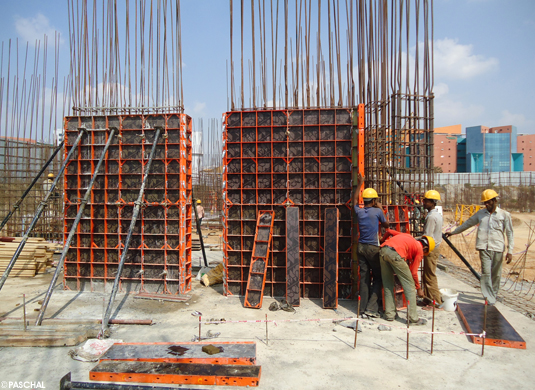Ever wondered how those towering skyscrapers or sleek bridges get their shape? The secret lies in construction formwork, the unsung hero of the building world. But it’s more than just wood and metal. This blog will dive into the nitty-gritty of engineering and material science that go into creating the perfect mould for your concrete masterpiece. From understanding loads and stresses to selecting the right materials, we’ll break it down so even a non-engineer can appreciate the science behind construction formwork, especially concrete formwork. Let’s get building!
Key Engineering Principles
Structural Integrity
Formwork must be designed to withstand the loads of wet concrete, workers, and equipment, ensuring stability and rigidity to prevent deformation or collapse during concrete pouring and curing.
Load Distribution
Proper load distribution is crucial to avoid localised stress points leading to failure. Utilising supports and bracing to distribute the weight of the concrete evenly.
Safety Considerations
Incorporating safety features to protect workers during construction.
Ensuring that formwork systems comply with local safety regulations and standards.
Efficiency and Reusability
Designing formwork for easy assembly, disassembly, and reuse to reduce costs and construction time. Using modular systems that can be adapted for different projects.
Materials Science in Formwork Design
Material Selection
Choosing materials that offer the necessary strength, durability, and flexibility.
Common materials include:
- Timber
- Steel
- Aluminium
- Engineered Wood Products.
Concrete Interaction
- Understanding how different materials interact with concrete to prevent issues like adhesion or chemical reactions.
- Coatings or treatments can be used to improve the performance and longevity of formwork materials.
Thermal Properties
- Considering the thermal properties of formwork materials to manage the heat generated during concrete curing.
- Using insulating materials to control temperature variations and prevent thermal cracking.
Durability and Maintenance
- Selecting materials that can withstand the harsh conditions of construction sites.
- Implementing maintenance practices to extend the life of formwork systems.
Effective Formwork Design and Construction
Precision in Design
- Accurate design and planning to ensure that formwork fits the project specifications.
- Using advanced software and modelling techniques to create detailed formwork plans.
Concrete Pouring Techniques
Employing proper techniques to pour concrete evenly and avoid segregation.
Monitoring the rate of pour to prevent excessive pressure on the formwork.
Concrete Pumping
- Utilising concrete pumping to place concrete in hard-to-reach areas efficiently.
- Ensuring that the formwork can handle pumped concrete’s pressure and flow rate.
Collaboration with Contractors
- Working closely with concrete formworks contractors in Maroubra, Sydney, to ensure that formwork design meets practical construction needs.
- Coordinating with contractors to address any on-site challenges and adjustments.
In-Depth Look: Materials Science in Formwork Design
Material Selection
Choosing the right materials for formwork design is crucial to ensure the strength, durability, and flexibility needed for effective concrete pouring and pumping. Here’s a deeper dive into the common materials used:
Timber
- Strength and Flexibility: Timber is widely used due to its natural strength and flexibility. It can be easily cut and shaped to fit various formwork designs.
- Cost-Effective: Timber is generally more affordable compared to other materials, making it a popular choice for many projects.
- Ease of Handling: Its lightweight nature makes it easy to handle and install, reducing labour costs and time.
- Sustainability: When sourced from sustainable forests, timber is an eco-friendly option.
Steel
- High Strength: Steel formwork offers exceptional strength and can withstand high pressures from concrete pouring and pumping.
- Durability: Steel is highly durable and can be reused multiple times, making it cost-effective in the long run.
- Precision: Steel formwork provides precise and smooth finishes, which is ideal for high-quality concrete surfaces.
- Resistance to Deformation: Unlike timber, steel does not warp or deform, ensuring consistent results.
Aluminum
- Lightweight: Aluminum formwork is lighter than steel, making it easier to transport and handle on-site.
- Corrosion Resistance: Aluminum is resistant to corrosion, which enhances its longevity and reduces maintenance costs.
- Reusability: Similar to steel, aluminium formwork can be reused multiple times, offering good value for money.
- Flexibility: It can be easily moulded into various shapes and sizes, providing versatility in formwork design.
Engineered Wood Products
- Enhanced Properties: Engineered wood products, such as plywood and laminated veneer lumber (LVL), offer enhanced strength and stability compared to natural timber.
- Consistency: These materials provide consistent quality and performance, reducing the risk of defects.
- Versatility: Engineered wood can be used for a wide range of formwork applications, from simple to complex designs.
- Cost-Effective: They are often more affordable than steel or aluminium while still offering good durability and reusability.
OVERVIEW
Selecting the right materials for formwork design is essential for ensuring the success of concrete pouring and pumping projects. By understanding the properties and benefits of timber, steel, aluminium, and engineered wood products, contractors can make informed decisions that enhance the efficiency, durability, and quality of their formwork systems.
For projects in Maroubra, Sydney, working with experienced concrete formworks contractors can further ensure that the chosen materials and designs meet the specific needs of the construction site.
SUMMARY
Effective formwork design and construction rely on a deep understanding of engineering principles and materials science. By focusing on structural integrity, load distribution, safety, and material properties, formwork systems can be designed to meet the demands of modern construction projects. Collaboration with experienced contractors ensures that these designs are implemented successfully, resulting in safe, efficient, and high-quality concrete structures.













